P.A.O.K.
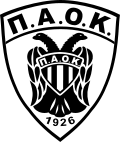 | |
| Full name |
Pan-Thessaloniki Athletic Club of Constantinopolitans Πανθεσσαλονίκειος Αθλητικός Όμιλος Κωνσταντινοπολιτών |
|---|---|
| Nickname | Dikefalos Tou Vorra (Two Headed Eagle of the North) |
| Founded | 1926 |
| Colours | Black, White |
| Chairman | Thanasis Katsaris |
| Website | Club home page |
| | |||
|---|---|---|---|
| |
| ||
| |
|
| |
| |
|
| |
| |
|
| |
| |
|
||
| |
|
| |
| |
|
| |
| |
|
| |
| |
|
| |
| |
|
|
|
P.A.O.K. (Greek: Π.Α.Ο.Κ., Πανθεσσαλονίκειος Αθλητικός Όμιλος Κωνσταντινοπολιτών, Panthessalonikeios Athlitikós Ómilos Constantinoupoliton, Pan-Thessaloniki Athletic Club of Constantinopolitans),[1][2] known in European competitions as A.C. PAOK[3][4] (Α.Σ. Π.Α.Ο.Κ.),[5][6][7][8] is a major multi-sports club in Thessaloniki, Greece. The club is home to several teams, including football, basketball, volleyball, handball, water polo, swimming, wrestling, ice hockey, and weightlifting. PAOK was founded in 1926. Because of its crest, it is also known as the "Two-Headed Eagle of the North", in contrast with AEK, the "Two-Headed Eagle of the South". They are one of the most popular Greek clubs with millions of fans all over Greece (mostly in Northern Greece but not only), such as the Greek diaspora.
History



PAOK is the successor of Hermes Sports Club (Greek: Ερμής), which was formed in 1877 by the Greek community of Pera, a district of Istanbul (then Constantinople).[9]
The football club was founded in 1926.[10] It was created by Constantinopolitans who fled to Thessaloniki after the Greek defeat in the Greco-Turkish War, although it was open to every citizen of Thessaloniki, leading to a minor rivalry with AEK Thessaloniki, the other Constantinopolitan team of the city, in which played only refugees. The original logo of PAOK was a horseshoe and a four-leaf clover.[11]
The club's first charter was approved on 20 April 1926 by a decision of the Thessaloniki Court of First Instance (No. 822). The club's founding members were A. Angelopoulos, A. Athanasiadis, K. Anagnostidis, M. Ventourellis, F. Vyzantinos ,V.Karapiperis, A. Dimitriadis, D. Dimitriadis, N. Zoumboulidis, M. Theodosiadis, T. Ioakimopoulos, P. Kalpaktsoglou, T. Kartsambekis, D. Koemtzopoulos, K. Koemtzopoulos, P. Kontopoulos, K. Kritikos, M. Konstantinidis, P. Maletskas, I. Nikolaidis, L. Papadopoulos, F. Samantzopoulos, T. Tsoulkas, M. Tsoulkas, S. Triantafyllidis and T. Triantafyllidis (who was also its first Chairman).[12]
P.A.O.K.'s first Board of Directors, serving between 1926 and 1927, consisted of:
- T. Triantafyllidis (Chairman)
- P. Kalpaktsoglou (1st Vice-Chairman)
- A. Athanasiadis (2nd Vice Chairman)
- V. Karapiperis (3rd Vice Chairman)
- K. Kritikos (Hon. Secretary)
- M. Tsoulkas (Secretary)
- T. Ioakimopoulos (Treasurer)
- A. Angelopoulos (Football Steward)
- M. Konstantinidis (Director)
- S. Triantafyllidis (Director)
PAOK played their first (informal) game on May 4, 1926, at the Thermaikos stadium, defeating Megas Alexandros Thessaloniki 2-1. The first coach of the club spent five years on the team's bench, and was unpaid, Kostas Andreadis.[13] Their first captain was Michalis Ventourelis.[14]
The first professional contract was signed by the club on 5 September 1928. The contract stipulated that the French footballer Raymond Etienne – of Jewish descent from Pera Club – would be paid 4,000 drachmas per month. The contract was signed by Dr. Meletiou, the PAOK chairman, and Mr. Sakellaropoulos, the Hon. Secretary.[15]
In early 1929, AEK Thessaloniki was virtually dissolved, and absorbed by PAOK. PAOK changed their emblem, adopted the two-headed eagle, took over the installations of AEK Thessaloniki including the syntrivani area. The eagle symbolizes the origins of the club in the former Byzantine capital, Constantinople, and the legacy of the Greek refugees from the Ottoman Empire.[11]
In 1937, PAOK won his first title, the Macedonia (EPSM or Thessaloniki) Championship, and participated in the Pan-Hellenic Championship, finishing second. The remarkable 1937 team included: Sotiriadis, Vatikis, Goulios, Kontopoulos, Bostantzoglou, Panidis, Glaros, Kritas, Ioannidis, Kalogiannis, Koukoulas, Kosmidis, Apostolou, Vafiadis, Vasiliadis, Anastasiadis, Moschidis, Tzakatzoglou, Zacapidas.[16]
Colours and symbols

The club's traditional colours are black, as sadness for the Asia Minor Catastrophe of 1922 and the end of the Greek presence in Anatolia, and white as hope for recovery.[17] Created by Constantinopolitans, the new club nevertheless was open to every citizen of Thessaloniki, leading to a minor rivalry with AEK Thessaloniki, the other Constantinopolitan team of the city, in which played only refugees. The original logo of PAOK was a horseshoe and a four-leaf clover.
In early 1929, AEK Thessaloniki was virtually dissolved, and absorbed by PAOK. The current symbol since 1929 is the two-headed eagle. The eagle symbolizes the origins of the club in the former Byzantine capital, Constantinople, and the legacy of the Greek refugees from the Ottoman Empire. Under the leadership of Ivan Savvidis a gold stripe was added to the crest of the FC, as a symbol of glory and renaissance of the club.[18]
Supporters
Gate 4 of Toumba Stadium is where most of PAOK fan clubs assemble. They support all the teams within the PAOK Sports Society, wearing the club's colors and symbols and maintaining firms all over Greece. Gate 4 gave its name to the oldest PAOK fan club, founded in 1963. Other fan clubs include several SF of PAOK (Syndesmoi Filon, Friends Societies) found all over Greece and in Diaspora.
In the night of 4 October 1999 a road accident took place in the Vale of Tempe, Thessaly, with 6 fans of the team killed. An annual ceremony takes place since then.[19]
Rivalries
P.A.O.K.'s main rivals are the teams of Olympiacos, Aris, Panathinaikos, AEK. The biggest rivalry is against Olympiacos and second with Aris. The derby against Olympiacos is the fiercest, representing more than any other, the animosity between Athens/Attica and Thessaloniki. The rivalry started in the 1960s when Olympiacos tried, and failed, to sign Giorgos Koudas, one of the best players of his time, from PAOK.
PAOK departments
Football
Men's football
- Greek Championships: 2
- Greek Cups: 5
- Greater Greece Cup: 1
- 1973
Football kit evolution
|
1925–26
|
1936–37
|
1938–39
|
1970-71
|
1984–85
|
1990–91 [20]
|
2000–03
|
|
2004–05
|
2005–06
|
2006–09
|
2016-17
|
2017-18
|
Alternative
|
2000–01
|
2001–02
|
2004–05
|
2014–15
|
2015-16
|
2016-17
|
2017-18
|

Women's football
- Greek Women's Championship: 12 (record)
- 2001-02, 2005–06, 2006–07, 2007–08, 2008–09, 2009–10, 2010–11, 2011–12, 2012–13, 2014–15, 2015-16, 2016-17
- Greek Women's Cup: 6 (record)
- 2001-02, 2012–13, 2013–14, 2014-15, 2015-16, 2016-17
Men's Basketball
- Greek Championships: 2
- 1959, 1992
- Greek Cups: 3
- 1984, 1995, 1999
- Cup Winners' Cup: 1
- Korać Cup: 1
Men's Volleyball
- Greek Championship: 3
- 2015, 2016, 2017
- Greek Cup: 1
- 2015
Men's handball
- Greek Championships: 3
- 2009, 2010, 2015
- Greek Cups: 3
- 2012, 2015, 2017
- Greek beach handball championship: 1
- 2001
Women's handball
- Greek Championship: 1
- 2013
- Greek Cup: 2
- 2014, 2016
Athletics
- 3 Greek women's Open Athletics Championships: 1976, 1977, 1982
- 2 Greek women's Cross Country Championships : 1968, 1974
Roller Hockey
- 1 Greek men's Championship: 2008
- 1 Balkan Cup: 2007
Swimming
- 1 Greek OPEN Championship: 1987
Weightlifting
- 1 Greek men's Championship: 2006
Cycling
- 1 Greek men's Championship Mountain Bike: 2002
Wrestling
- 1 Greek men's Championship Greco-Roman: 2017
Boxing
- 2 Greek men's Championships: 2003, 2007
Tae Kwon Do
PAOK created a Tae Kwon Do department in 2002. Currently, over 50 active athletes practice daily in Gate 8 in Toumba Stadium.
European honours of team sports
| Season | Men's Football | Women's Football | Men's Basketball | Men's Volleyball | Men's Roller Hockey |
|---|---|---|---|---|---|
| 1973–74 | UEFA Cup Winners' Cup Quarter-finals |
||||
| 1989–90 | FIBA European Cup Winner's Cup Semi-finals |
||||
| 1990–91 | FIBA European Cup Winner's Cup Winners |
||||
| 1991–92 | FIBA European Cup Final |
||||
| 1992-93 | FIBA European League 3rd place |
||||
| 1993-94 | FIBA Korać Cup Winners |
||||
| 1995–96 | FIBA European Cup Final |
||||
| 2006-07 | Balkan Amateur Hockey League Winners | ||||
| 2009-10 | UEFA Women's Champions League Round of 32 |
||||
| 2016-17 | CEV Cup Fase of 16 |
Notable athletes
- Football: Men: Dimitar Berbatov, Diego Biseswar, Lazaros Christodoulopoulos, Sérgio Conceição, Pablo Gabriel García, Georgios Georgiadis (footballer), Kostas Frantzeskos, Konstantinos Iosifidis, Giorgos Koudas, Hedwiges Maduro, Léo Matos, Bibras Natkho, Lucas Pérez, Aleksandar Prijović, Stavros Sarafis, Christos Terzanidis, Vieirinha, Theodoros Zagorakis Women: Jelena Dimitrijević (footballer), Dimitra Panteliadou
- Basketball: Men: Walter Berry (basketball), Nikos Boudouris, Claudio Coldebella, Panagiotis Fasoulas, Rasho Nesterovic, John Korfas, Cliff Levingston, Ibrahim Kutluay, Loukas Mavrokefalidis, Damir Mulaomerovic, Bane Prelevic, Efthimios Rentzias, Zoran Savic, Peja Stojaković, Scott Skiles, Dejan Tomasevic
- Volleyball: Men: Dante Amaral, Marko Bojić, Rolando Cepeda, Ernardo Gómez, Vladimir Grbić, Kevin Hansen (volleyball), Matti Hietanen, Jayson Jablonsky, Javier Jiménez (volleyball), Plamen Konstantinov, Vasileios Kournetas, Andrej Kravárik, David Lee (volleyball), Paul Lotman, Riley McKibbin, Đula Mešter, Olli-Pekka Ojansivu, Evan Patak, Vlado Petković, Konstantinos Prousalis, Clayton Stanley, Riley Salmon, Nikolaos Smaragdis, Saša Starović, Ronald Zoodsma
- Athletics: Men: Michalis Akritidis, Themistoklis Akritidis, Dimitrios Kokotis, Konstantinos Koukodimos, Dimitrios Koutsoukis Women: Vasiliki Anastasiou, Xanthipi Koukoumaka, Voula Patoulidou
- Swimming: Men: Christos Papadopoulos Women: Kalliopi Araouzou, Antonia Machaira, Aikaterini Sarakatsani, Katerina Stikoudi
PAOK Presidents

AC PAOK
PAOK FC
|
Notable supporters
|
|
Gallery
Football
 The team of 1928-29
The team of 1928-29 The team of 1936-37
The team of 1936-37 Stavros Sarafis, top goalscorer of the team
Stavros Sarafis, top goalscorer of the team



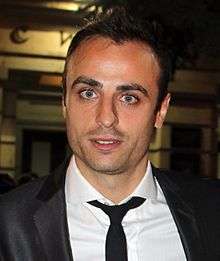


Basketball
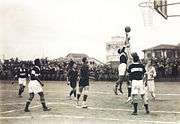 Paok vs Chanth in the '20s
Paok vs Chanth in the '20s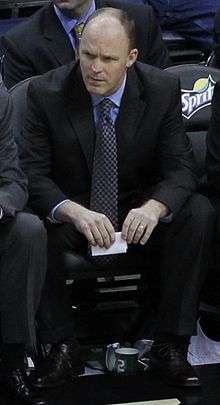
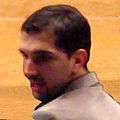
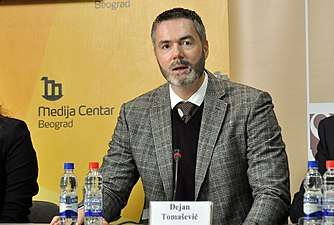

Volleytball
References
- ↑ uefa.com Myths, heroes and legends: PAOK in focus
- ↑ liberiaentertainment.com Sekou Oliseh Jabateh wins big sports award in Greece
- ↑ eurohandball.com A.C. PAOK
- ↑ uefa.com 2013/14 entries and coefficients
- ↑ acpaok.gr (in Greek)
- ↑ chessfed.gr (in Greek)
- ↑ sport-fm.gr (in Greek)
- ↑ onsports.gr (in Greek)
- ↑ "History". PAOKFC. Retrieved 26 June 2015.
- ↑ "PAOK THESSALONIKI FC". Soccerway. Perform. Retrieved 24 June 2017.
- 1 2 "Αφιέρωμα - PAOKFC".
- ↑ PaokFc.gr
- ↑ "90 χρόνια ΠΑΟΚ!90 χρόνια προπονητές!". paokvoice. Retrieved 14 July 2017.
- ↑ "The first captain". paok90. Retrieved 14 July 2017.
- ↑ "The unknown first foreign player of PAOK Raymond Ettienne". paokmania.gr. Archived from the original on 13 February 2013. Retrieved 10 May 2013.
- ↑ "Ο πρώτος τίτλος!". paok90. Retrieved 14 July 2017.
- ↑ "Η ιστορία του ΠΑΟΚ - History of PAOK". sansimera.gr.
- ↑ To νέο λογότυπο του ΠΑΟΚ
- ↑ Η μαύρη μέρα του ΠΑΟΚ
- ↑ http://www.contra.gr/Basketball/article3589317.ece/BINARY/w460/1990-91.jpg
- ↑ Aπ' τον Παντελάκη στον Ιβάν




